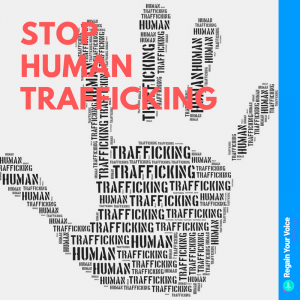It might surprise some people to learn that slavery still exists today. Perhaps more surprising is that it exists here in America, and no one is immune from its effects. Modern-day slavery, or human trafficking, is estimated to bring in global profits of about $150 billion a year—$99 billion from sexual exploitation and $51 billion from other forms of forced economic exploitation, including domestic work, agriculture, and other economic activities, according to the International Labor Organization. It’s extremely difficult to determine how many victims and survivors of human trafficking there are in the world, but it is estimated that there are 40.3 million people currently being trafficked around the globe. It’s important to note that human trafficking does not necessarily mean that victims are being moved across borders. The crime of human trafficking does not require any forced movement whatsoever.
MYTHS AND MISUNDERSTANDINGS
There are a lot of myths and misunderstandings regarding who is vulnerable to being trafficked. The truth is that anyone can become a victim of human trafficking, but there are risk factors which can make certain people more vulnerable. These risk factors include recent migration or relocation, substance use, mental health concerns, involvement with the child welfare system and being a runaway or homeless youth. Traffickers will often use their victims’ vulnerabilities in order to create dependency. Everyone has vulnerabilities that can be exploited.
Another misconception about human trafficking is that victims and survivors are generally non-citizens or migrants. While recent migration or relocation are risk factors which can make a person more vulnerable to being trafficked, this is not the only population affected. The FBI reports that from 2008 – 2010, 83% of sex trafficking victims found within the US were US citizens. Victims and survivors of human trafficking represent every race and ethnicity, but some forms of trafficking are more likely to affect specific ethnic groups. For example, federal and state cases of labor trafficking in the US show that both domestic and foreign-born—citizen and non-citizen—individuals are exploited in a range of settings across the country. According to the Human Trafficking Hotline, labor trafficking includes situations of debt bondage, forced labor, and involuntary child labor, and traffickers use coercion, like violence, threats, and lies to force people to work against their will in many industries. Common types of labor trafficking include people forced to work as domestic servants, farmworkers threatened with violence and reporting of non-citizens to authorities, or factory workers held in inhumane conditions with little to no pay. There are many coercion tactics that traffickers employ in order to continue to exploit victims.
WHY DIDN’T THEY JUST LEAVE?
Not everyone in the commercial sex industry is a victim of human trafficking, but many are. Sex-for-hire becomes trafficking when someone is forced or coerced into working in the commercial sex trade against their will. When it comes to sexual exploitation, traffickers use psychological methods, such as trauma bonding, also known as Stockholm Syndrome. Trauma bonding can create a very complex situation where the abuser uses a combination of fear and safety to control their victim and build a relationship that the victim becomes dependent on. A trauma bond is what explains why a victim may, seemingly voluntarily, continue a relationship with their abuser, but the coercion involved makes the situation far from voluntary for the victim. This is often seen in domestic violence, child sexual abuse, and commercial sexual exploitation such as sex trafficking.
When it comes to commercial sexual exploitation, it is often the case that abusers groom their victims and exploit their vulnerabilities to lure them in with false promises such as the prospect of a romantic relationship, housing, or a good job. Overtime they begin to isolate their victims from their families and friends. Once they are recruited to perform non-consensual sex work, traffickers use violence, threats, lies, debt bondage, drugs, or other forms of control and manipulation to keep victims in the commercial sexual exploitation industry. Further, traffickers often take their victims’ identity documents, including birth certificates, passports, and drivers’ licenses in order to further control them. If a victim is able to escape, they are often unable to access shelters and services or support themselves due to the dependence that their abuser has created. As a result, survivors frequently return to their traffickers, just as victims of domestic abuse often return to their abusive partners.
Sex trafficking is happening all around us. It can be found in every country, in every state, and in every city and town. According to End Slavery Now, sex trafficking is occurring in “escort services, at truck stops, in strip clubs, within street prostitution, in fake massage parlors, and on internet networking and advertisement spaces”. It is important to educate ourselves and others about the truth behind the headlines and the stories that stay hidden. The more awareness that we can bring to the issues of human trafficking, the better prepared we can be to report potential cases and support survivors.
If you would like to learn more about human trafficking or are seeking support, please visit:
National Human Trafficking Hotline
Toll-Free: 1 (888) 373-7888
SMS: 233733 (Text “HELP” or “INFO”)
Hours: 24 hours, 7 days a week
Languages: English, Spanish, and over 200 more languages
ECPAT-USA (End Child Prostitution Child Pornography and Trafficking)
ATEST (Alliance to End Slavery & Trafficking)
My recommendations:
Book: “The Last Girl” by Nadia Murad
- Memoir of a Yazidi woman’s experience as a survivor of the ISIS slave trade
Book: “Bitter Chocolate: Anatomy of an Industry” by Carol Off
- Labor trafficking and child exploitation in the cocoa industry
Podcast: Sold in America
- Eight-episode series on the commercial sex industry in America
Film: “Doing Money” (BBC/ RTÉ)
- Based on a true story of how a woman was kidnapped and sex trafficked
Documentary Film: “I am Jane Doe” (Available on Netflix)
- Stories of survivors of child sex trafficking in America
Documentary Film: “The True Cost” (Available on Amazon)
- Labor exploitation in the fashion industry
TV Docuseries Episode: “Stacey Dooley Investigates: Sex Trafficking in Cambodia” (BBC)
- Investigative look into child sex trafficking and sex trafficking tourism in Cambodia
TV Docuseries Episode: “The Traffickers: The Girl in the Window” (Available on Amazon Video)
- Investigative look into female refugees being trafficked in Europe

